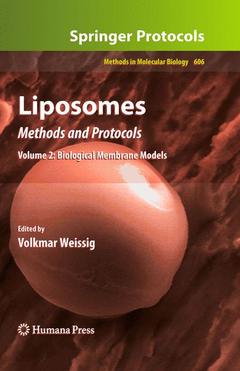1. Utilization of Liposomes for Studying Drug Transfer and Uptake Alfred Fahr and Xiangli Liu 2. The Use of Liposomes in the Study of Drug Metabolism: A Method to Incorporate the Enzymes of the Cytochrome P450 Monooxygenase System into Phospholipid, Bilayer Vesicles James R. Reed 3. Use of Liposomes to Study Cellular Osmosensors Reinhard Krämer, Sascha Nicklisch, and Vera Ott 4. Studying Mechanosensitive Ion Channels Using Liposomes Boris Martinac, Paul R. Rohde, Andrew R. Battle, Evgeny Petrov, Prithwish Pal, Alexander Fook Weng Foo, Valeria Vásquez, Thuan Huynh, and Anna Kloda 5. Studying Amino Acid Transport Using Liposomes Cesare Indiveri 6. Use of Liposomes for Studying Interactions of Soluble Proteins with Cellular Membranes Chris Höfer, Andreas Herrmann, and Peter Müller 7. Liposomal Reconstitution of Monotopic Integral Membrane Proteins Zahra MirAfzali and David L. DeWitt 8. The Reconstitution of Actin Polymerization on Liposomes Mark Stamnes and Weidong Xu 9. Electroformation of Giant Unilamellar Vesicles from Native Membranes and Organic Lipid Mixtures for the Study of Lipid Domains Under Physiological Ionic-Strength Conditions L.-Ruth Montes, Hasna Ahyayauch, Maitane Ibarguren, Jesus Sot, Alicia Alonso, Luis A. Bagatolli, and Felix M. Goñi 10. Visualization of Lipid Domain Specific Protein Sorting in Giant Unilamellar Vesicles Martin Stöckl, Jörg Nikolaus, and Andreas Herrmann 11. Biosynthesis of Proteins Inside Liposomes Pasquale Stano, Yutetsu Kuruma, Tereza Pereira de Souza, and Pier Luigi Luisi 12. Study of Respiratory Cytochromes in Liposomes Iseli L. Nantes, Cintia Kawai, Felipe S. Pessoto, and Katia C.U. Mugnol 13. Use of Liposomes to Evaluate the Role of Membrane Interactions onAntioxidant Activity Salette Reis, Marlene Lúcio, Marcela Segundo, and José L.F.C. Lima 14. Studying Colloidal Aggregation Using Liposomes Juan Sabín, Gerardo Prieto, Juan M. Ruso, and Félix Sarmiento 15. Assessment of Liposome-Cell Interactions Jan A.A.M. Kamps 16. Methods to Monitor Liposome Fusion, Permeability, and Interaction with Cells Nejat Düzgünes, Henrique Faneca, and Maria C. Pedroso de Lima 17. The Use of Isothermal Titration Calorimetry to Study Multidrug Transport Proteins in Liposomes David Miller and Paula J. Booth 18. Studying Lipid Organization in Biological Membranes Using Liposomes and EPR Spin Labeling Witold K. Subczynski, Marija Raguz, and Justyna Widomska 19. Membrane Translocation Assayed by Fluorescence Spectroscopy Jana Broecker and Sandro Keller 20. Interaction of Lipids and Ligands with Nicotinic Acetylcholine Receptor Vesicles Assessed by Electron Paramagnetic Resonance Spectroscopy Hugo Rubén Arias 21. Environmental Scanning Electron Microscope Imaging of Vesicle Systems Yvonne Perrie, Habib Ali, Daniel J. Kirby, Afzal U.R. Mohammed, Sarah E. McNeil, and Anil Vangala 22. Freeze-Fracture Electron Microscopy on Domains in Lipid Mono- and Bilayer on Nano-Resolution Scale Brigitte Papahadjopoulos-Sternberg 23. Atomic Force Microscopy for the Characterization of Proteoliposomes Johannes Sitterberg, Maria Manuela Gaspar, Carsten Ehrhardt, and Udo Bakowsky 24. Method of Simultaneous Analysis of Liposome Components Using HPTLC/FID Sophia Hatziantoniou and Costas Demetzos 25. Viscometric Analysis of DNA-Lipid Complexes Sadao Hirota and Nejat Düzgünes 26. Fluorometric Analysis of Individual Cationic Lipid-DNA Complexes Edwin




